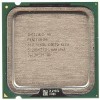Intel 640 User Guide - Page 34
On-Demand Mode, System Considerations
 |
UPC - 683728178901
View all Intel 640 manuals
Add to My Manuals
Save this manual to your list of manuals |
Page 34 highlights
Thermal Management Logic and Thermal Monitor Feature R 4.2.4 4.2.5 On-Demand Mode For testing purposes, the thermal control circuit may also be activated by setting bits in the ACPI MSRs. The MSRs may be set based on a particular system event (e.g., an interrupt generated after a system event), or may be set at any time through the operating system or custom driver control thus forcing the thermal control circuit on. This is referred to as "on-demand" mode. Activating the thermal control circuit may be useful for thermal solution investigations or for performance implication studies. When using the MSRs to activate the on-demand clock modulation feature, the duty cycle is configurable in steps of 12.5%, from 12.5% to 87.5%. For any duty cycle, the maximum time period the clocks are disabled is ~3 μs. This time period is frequency dependent, and decreases as frequency increases. To achieve different duty cycles, the length of time that the clocks are disabled remains constant, and the time period that the clocks are enabled is adjusted to achieve the desired ratio. For example, if the clock disable period is 3 µs, and a duty cycle of ¼ (25%) is selected, the clock on time would be reduced to approximately 1 μs [on time (1 μs) ÷ total cycle time (3 + 1) μs = ¼ duty cycle]. Similarly, for a duty cycle of 7/8 (87.5%), the clock on time would be extended to 21 μs [21 ÷ (21 + 3) = 7/8 duty cycle]. In a high temperature situation, if the thermal control circuit and ACPI MSRs (automatic and ondemand modes) are used simultaneously, the fixed duty cycle determined by automatic mode would take precedence. System Considerations Intel requires the Thermal Monitor and Thermal Control Circuit to be enabled for all Pentium 4 processors in the 775-land LGA package based systems. The thermal control circuit is intended to protect against short term thermal excursions that exceed the capability of a properly designed processor thermal solution. Thermal Monitor should not be relied upon to compensate for a thermal solution that does not meet the thermal profile up to the thermal design power (TDP). Each application program has its own unique power profile, although the profile has some variability due to loop decisions, I/O activity and interrupts. In general, compute intensive applications with a high cache hit rate dissipate more processor power than applications that are I/O intensive or have low cache hit rates. The processor TDP is based on measurements of processor power consumption while running various high power applications. This data is used to determine those applications that are interesting from a power perspective. These applications are then evaluated in a controlled thermal environment to determine their sensitivity to activation of the thermal control circuit. This data is used to derive the TDP targets published in the processor datasheet. A system designed to meet the thermal profile at TDP and TC-MAX values published in the processor datasheet greatly reduces the probability of real applications causing the thermal control circuit to activate under normal operating conditions. Systems that do not meet these specifications could be subject to more frequent activation of the thermal control circuit depending upon ambient air temperature and application power profile. Moreover, if a system is significantly under designed, there is a risk that the Thermal Monitor feature will not be capable of maintaining a safe operating temperature and the processor could shutdown and signal THERMTRIP#. 34 Thermal/Mechanical Design Guide















